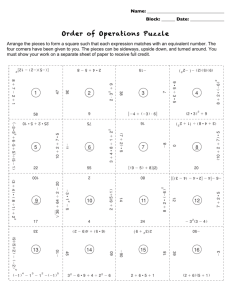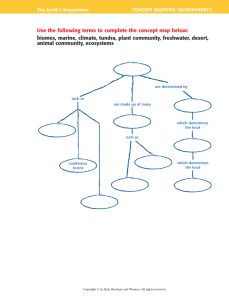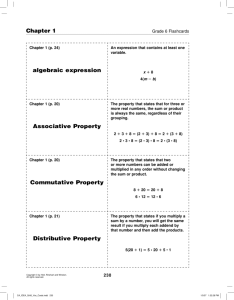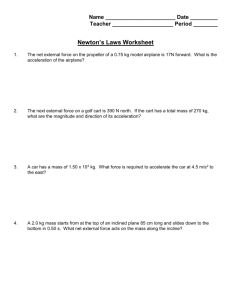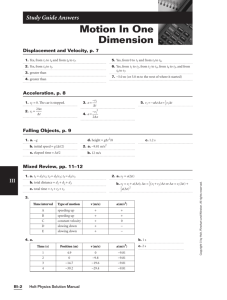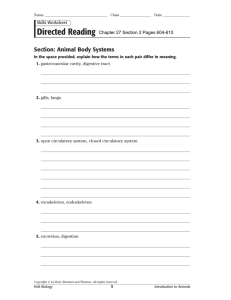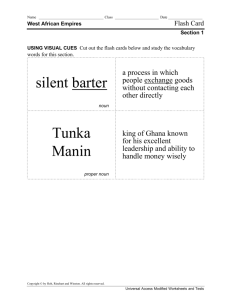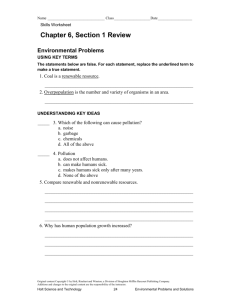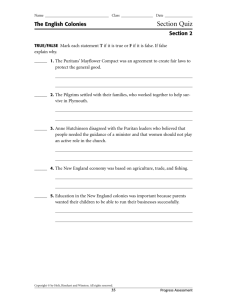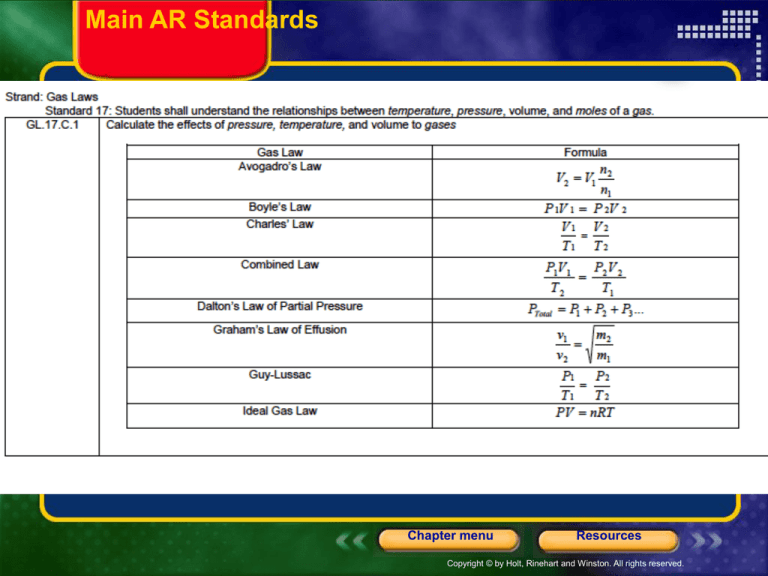
Main AR Standards
Chapter menu
Resources
Copyright © by Holt, Rinehart and Winston. All rights reserved.
AR STANDARDS for ch. 10-11
Chapter menu
Resources
Copyright © by Holt, Rinehart and Winston. All rights reserved.
Chapter 11
Gases
Table of Contents
Section 1 Gases and Pressure
Chapter menu
Resources
Copyright © by Holt, Rinehart and Winston. All rights reserved.
Chapter 11
Section 1 Gases and Pressure
Objectives
• Define pressure, give units of pressure, and describe
how pressure is measured.
• State the standard conditions of temperature and
pressure and convert units of pressure.
• Use Dalton’s law of partial pressures to calculate
partial pressures and total pressures.
Chapter menu
Resources
Copyright © by Holt, Rinehart and Winston. All rights reserved.
Chapter 11
Section 1 Gases and Pressure
Pressure and Force
• Pressure (P) is the force per unit area on a surface.
• Gas pressure is caused by collisions of the gas
molecules with each other and with surfaces with
which they come into contact.
• The pressure exerted by a gas depends on volume,
temperature, and the number of molecules present.
• The greater the number of collisions of gas molecules,
the higher the pressure will be.
Chapter menu
Resources
Copyright © by Holt, Rinehart and Winston. All rights reserved.
Chapter 11
Visual Concepts
Pressure - wait for video to play
QuickTime™ and a
Sorenson Video 3 decompressor
are needed to see this picture.
Chapter menu
Resources
Copyright © by Holt, Rinehart and Winston. All rights reserved.
Chapter 11
Visual Concepts
Equation for Pressure
Click below to watch the Visual Concept.
http://my.hrw.com/sh/hc6_003036809x/s
Visual Concept
tudent/ch11/sec01/vc01/hc611_01_v01fs
.htm
Chapter menu
Resources
Copyright © by Holt, Rinehart and Winston. All rights reserved.
Chapter 11
Section 1 Gases and Pressure
Pressure and Force
• The SI unit for force is the newton, (N), the force
that will increase the speed of a one-kilogram
mass by one meter per second each second that
the force is applied.
• example: consider a person with a mass of 51 kg.
At Earth’s surface, gravity has an acceleration of
9.8 m/s2.
• The force the person exerts on the ground is
therefore 51 kg 9.8 m/s2 = 500 kg • m/s2 = 500 N
Chapter menu
Resources
Copyright © by Holt, Rinehart and Winston. All rights reserved.
Chapter 11
Section 1 Gases and Pressure
Pressure and Force
• Pressure is force per unit area, so the pressure of a
500 N person on an area of the floor that is 325 cm2
is:
500 N ÷ 325 cm2 = 1.5 N/cm2
• The greater the force on a given area, the greater
the pressure.
• The smaller the area is on which a given force acts,
the greater the pressure.
Chapter menu
Resources
Copyright © by Holt, Rinehart and Winston. All rights reserved.
Chapter 11
Section 1 Gases and Pressure
Relationship Between Pressure, Force, and
Area
Chapter menu
Resources
Copyright © by Holt, Rinehart and Winston. All rights reserved.
13.1 Fluid Pressure
Atmospheric pressure is the sum of the individual pressures of
the various gases: 78% nitrogen, 21% oxygen, and 1% other
approximately.
Why do your ears pop when you change altitude such as
climbing a large mountain in a car ?
Density is lower and atmospheric pressure lower at higher
altitudes.
The outside pressure changes more quickly than your ear can
adjust which creates a pressure difference in pressure. When
unbalanced pressures equalize, popping sensation within a
small tube in your ear occurs.
Chapter 11
Section 1 Gases and Pressure
Pressure and Force, continued
Measuring Pressure
• A barometer is a device used to measure
atmospheric pressure. The first barometer was
introduced by Evangelista Torricelli in the early 1600s.
• Torricelli noticed that water pumps could raise water
only to a maximum height of about 34 feet.
• He wondered why this was so, and thought the height
must depend somehow on the weight of water
compared with the weight of air.
Chapter menu
Resources
Copyright © by Holt, Rinehart and Winston. All rights reserved.
Chapter 11
Section 1 Gases and Pressure
Pressure and Force, continued
Measuring Pressure, continued
• Torricelli reasoned that if the maximum height of a
water column depended on its weight, then mercury,
which is about 14 times as dense as water, could be
raised only about 1/14 as high as water.
• He tested this idea by sealing a long glass tube at one
end and filling it with mercury. Inverting the tube into a
dish of mercury, the mercury rose to a height of about
30 in. (760 mm), which is about 1/14 of 34 feet.
Chapter menu
Resources
Copyright © by Holt, Rinehart and Winston. All rights reserved.
Chapter 11
Visual Concepts
Barometer
Click below to watch the Visual Concept.
http://my.hrw.com/sh/hc6_003036809x/student/
Visual Concept
ch11/sec01/vc02/hc611_01_v02fs.htm
Chapter menu
Resources
Copyright © by Holt, Rinehart and Winston. All rights reserved.
Manometer
A manometer measures pressure of an enclosed gas
sample.
Chapter menu
Resources
Copyright © by Holt, Rinehart and Winston. All rights reserved.
Chapter 11
Section 1 Gases and Pressure
Pressure and Force, continued
Measuring Pressure, continued
• The common unit of pressure is millimeters of
mercury, symbolized mm Hg.
• A pressure of 1 mm Hg is also called 1 torr in honor of Torricelli
for his invention of the barometer.
• Pressures can also be measured in units of
atmospheres. Because the average atmospheric
pressure at sea level at 0°C is 760 mm Hg, one
atmosphere of pressure (atm) is defined as being
exactly equivalent to 760 mm Hg.
Chapter menu
Resources
Copyright © by Holt, Rinehart and Winston. All rights reserved.
Chapter 11
Section 1 Gases and Pressure
Pressure and Force, continued
Measuring Pressure, continued
• In SI, pressure is expressed in pascals. One
pascal (Pa) is defined as the pressure exerted by
a force of one newton (1 N) acting on an area of
one square meter.
• The unit is named for Blaise Pascal, a French mathematician and
philosopher who studied pressure during the seventeenth century.
• One pascal is a very small unit of pressure, so in many
cases, it is more convenient to express pressure in
kilopascals (kPa). 1 atm is equal to 101.325 kPa.
Chapter menu
Resources
Copyright © by Holt, Rinehart and Winston. All rights reserved.
Chapter 11
Section 1 Gases and Pressure
Units of Pressure
Chapter menu
Resources
Copyright © by Holt, Rinehart and Winston. All rights reserved.
Chapter 11
Section 1 Gases and Pressure
Pressure and Force, continued
Sample Problem A
The average atmospheric pressure in Denver, Colorado
is 0.830 atm. Express this pressure in
a. millimeters of mercury (mm Hg) and
b. kilopascals (kPa)
Chapter menu
Resources
Copyright © by Holt, Rinehart and Winston. All rights reserved.
Chapter 11
Section 1 Gases and Pressure
Pressure and Force, continued
Sample Problem A Solution
Given: atmospheric pressure = 0.830 atm
Unknown: a. pressure in mm Hg
b. pressure in kPa
Solution:
conversion factor
760 mm Hg
mm Hg
a. atm mm Hg; atm
atm
101.325 kPa
kPa
b. atm kPa; atm
atm
Chapter menu
Resources
Copyright © by Holt, Rinehart and Winston. All rights reserved.
Section 1 Gases and Pressure
Chapter 11
Pressure and Force, continued
Sample Problem A Solution, continued
conversion factor
a. 0.830 atm
b.
760 mm Hg
631 mm Hg
atm
101.325 kPa
0.830 atm
84.1 kPa
atm
Chapter menu
Resources
Copyright © by Holt, Rinehart and Winston. All rights reserved.
Practice Problems pg. 365
Complete problem #1-2 Practice problems pg. 365 in your
notes. You must show work to get credit.
Chapter menu
Resources
Copyright © by Holt, Rinehart and Winston. All rights reserved.
ANSWERS
Practice Problems pg. 365
Complete problem #1-2 Practice problems pg. 365 in your
notes.
Chapter menu
Resources
Copyright © by Holt, Rinehart and Winston. All rights reserved.
Chapter 11
Section 1 Gases and Pressure
Dalton’s Law of Partial Pressures
• The pressure of each gas in a mixture is called the
partial pressure of that gas.
• John Dalton, the English chemist who proposed the
atomic theory, discovered that the pressure exerted
by each gas in a mixture is independent of that
exerted by other gases present.
• Dalton’s law of partial pressures states that the
total pressure of a gas mixture is the sum of the
partial pressures of the component gases.
Chapter menu
Resources
Copyright © by Holt, Rinehart and Winston. All rights reserved.
Chapter 11
Visual Concepts
Dalton’s Law of Partial Pressures
Click below to watch the Visual Concept.
http://my.hrw.com/sh/hc6_003036809x/stud
Visual Concept
ent/ch11/sec01/vc04/hc611_01_v04fs.htm
Chapter menu
Resources
Copyright © by Holt, Rinehart and Winston. All rights reserved.
Chapter 11
Visual Concepts
Equation for Dalton’s Law of Partial Pressures
Click below to watch the Visual Concept.
http://my.hrw.com/sh/hc6_003036809x/stude
Visual Concept
nt/ch11/sec01/vc05/hc611_01_v05fs.htm
Chapter menu
Resources
Copyright © by Holt, Rinehart and Winston. All rights reserved.
Chapter 11
Section 1 Gases and Pressure
Dalton’s Law of Partial Pressures, continued
Gases Collected by Water Displacement
• Gases produced in the laboratory are often collected over
water. The gas produced by the reaction displaces the
water in the reaction bottle. A gas collected by water
displacement is not pure but is always mixed with water
vapor.
• Water molecules at the liquid surface evaporate and mix
with the gas molecules. Water vapor, like other gases,
exerts a pressure known as vapor pressure.
• Dalton’s law of partial pressures can be applied to
calculate the pressures of gases collected in this way.
Chapter menu
Resources
Copyright © by Holt, Rinehart and Winston. All rights reserved.
Chapter 11
Section 1 Gases and Pressure
Particle Model for a Gas Collected Over Water
Chapter menu
Resources
Copyright © by Holt, Rinehart and Winston. All rights reserved.
Chapter 11
Section 1 Gases and Pressure
Dalton’s Law of Partial Pressures, continued
Gases Collected by Water Displacement, continued
• To determine the pressure of a gas inside a collection
bottle, you would use the following equation, which is an
instance of Dalton’s law of partial pressures.
Patm = Pgas + PH O
2
• If you raise the bottle until the water levels inside and
outside the bottle are the same, the total pressure
outside and inside the bottle will be the same.
• Reading the atmospheric pressure from a barometer
and looking up the value of P at the temperature of
O
the experiment in a table, youH2can
calculate Pgas.
Chapter menu
Resources
Copyright © by Holt, Rinehart and Winston. All rights reserved.
Chapter 11
Section 1 Gases and Pressure
Dalton’s Law of Partial Pressures, continued
Sample Problem B
Oxygen gas from the decomposition of potassium
chlorate, KClO3, was collected by water displacement.
The barometric pressure and the temperature during the
experiment were 731.0 torr and 20.0°C. respectively.
What was the partial pressure of the oxygen collected?
Chapter menu
Resources
Copyright © by Holt, Rinehart and Winston. All rights reserved.
Section 1 Gases and Pressure
Chapter 11
Dalton’s Law of Partial Pressures, continued
Sample Problem B Solution
Given: PT = Patm = 731.0 torr
PH O= 17.5 torr (vapor pressure of water at 20.0°C, from
table A-8 in your book)
Patm = PO PH O
Unknown: PO in torr
Solution:
2
2
2
2
start with the equation: Patm PO2 PH2O
rearrange algebraically to: PO2 Patm PH2O
Chapter menu
Resources
Copyright © by Holt, Rinehart and Winston. All rights reserved.
Chapter 11
Section 1 Gases and Pressure
Dalton’s Law of Partial Pressures, continued
Sample Problem B Solution, continued
substitute the given values of Patm and P
into the
H2O
equation:
PO 731.0 torr 17.5 torr 713.5 torr
2
Chapter menu
Resources
Copyright © by Holt, Rinehart and Winston. All rights reserved.
Section Review Problems
pg. 367
Answer section review problems pg. 367 #1, 3-5 in your
notes. Show your work.
Chapter menu
Resources
Copyright © by Holt, Rinehart and Winston. All rights reserved.
ANSWERS
Section Review Problems pg. 367
Answer section review problems pg. 367 #1, 3-5 in your
notes. Show your work.
Chapter menu
Resources
Copyright © by Holt, Rinehart and Winston. All rights reserved.
HIGHLIGHTS OF 11.1
Slide
of 25
© Copyright Pearson Prentice Hall
End Show
SECTION PROBLEMS
Explore these interactive demonstrations to learn how to
use equations to solve science problems.
Section 1: Gases and Pressure
Atmospheric Pressure Conversion See how it's done Try
it yourself
PARTIAL Pressure See how it's done Try it yourself
Slide
of 25
© Copyright Pearson Prentice Hall
End Show
Online Self-Check Quiz
Complete the online Quiz and record answers.
Ask if you have any questions about your
answers.
click here for online Quiz 11.1
(8 questions)
You must be in the “Play mode” for the
slideshow for hyperlink to work.
Slide
of 25
© Copyright Pearson Prentice Hall
End Show
VIDEOS FOR ADDITIONAL INSTRUCTION
Additional Videos for
•Chapter 11: Gases
Section 11.1: Gas and Pressure
•Dalton's Law
•Pressure
•Barometer
•Atmospheric Pressure
Slide
of 28
© Copyright Pearson Prentice Hall
End Show
End of Chapter 11.1 Show
Chapter menu
Resources
Copyright © by Holt, Rinehart and Winston. All rights reserved.

